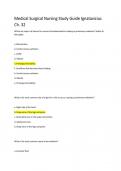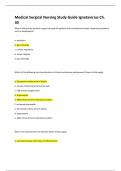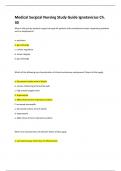Medical Surgical Nursing Study Guid Ignatavicius
Chamberlain College of Nursing
All 3 results
Sort by

-
Medical Surgical Nursing Study Guide Ignatavicius Ch. 32
- Exam (elaborations) • 35 pages • 2024
-
- $12.79
- + learn more
Which are major risk factors for venous thromboembolism leading to pulmonary embolism? Select all that apply. a. Malnutrition b. Central venous catheters c. COPD d. Obesity e. Prolonged immobility f. Conditions that decrease blood clotting b. Central venous catheters d. Obesity e. Prolonged immobility

-
Medical Surgical Nursing Study Guide Ignatavicius Ch. 30 Download To Score A+
- Exam (elaborations) • 31 pages • 2024
-
- $12.99
- + learn more
What is the priority medical-surgical concept for patients with noninfectious lower respiratory problems such as emphysema? a. perfusion b. gas exchange c. cellular regulation d. tissue integrity b. gas exchange Which of the following are characteristics of chronic pulmonary emphysema? Select all that apply. a. Decreased surface area of alveoli b. chronic thickening of bronchial walls c. high arterial oxygen level d. hypercapnia e. ABGs show chronic respiratory acidosis f. increased...

-
Medical Surgical Nursing Study Guide Ignatavicius Ch. 30 Fully Solved Solution Rated A+
- Exam (elaborations) • 31 pages • 2024
-
- $11.99
- + learn more
What is the priority medical-surgical concept for patients with noninfectious lower respiratory problems such as emphysema? a. perfusion b. gas exchange c. cellular regulation d. tissue integrity b. gas exchange Which of the following are characteristics of chronic pulmonary emphysema? Select all that apply. a. Decreased surface area of alveoli b. chronic thickening of bronchial walls c. high arterial oxygen level d. hypercapnia e. ABGs show chronic respiratory acidosis f. increased...

How did he do that? By selling his study resources on Stuvia. Try it yourself! Discover all about earning on Stuvia


